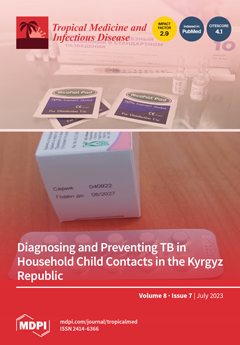The present study aimed to evaluate the in vitro, in vivo, and safety of
Stachys lavandulifolia Vahl. methanolic extract (SLME) against acute toxoplasmosis caused by
Toxoplasma gondii RH strain in mice. Methods: MTT (3-(4,5-Dimethylthiazol-2-yl)-2,5-diphenyltetrazolium bromide) assay was used to evaluate the in vitro effect
[...] Read more.
The present study aimed to evaluate the in vitro, in vivo, and safety of
Stachys lavandulifolia Vahl. methanolic extract (SLME) against acute toxoplasmosis caused by
Toxoplasma gondii RH strain in mice. Methods: MTT (3-(4,5-Dimethylthiazol-2-yl)-2,5-diphenyltetrazolium bromide) assay was used to evaluate the in vitro effect of the SLME on
T. gondii tachyzoites. Totally, 72 male BALB/c mice (40 mice for in vivo evaluation of SLME and 32 mice for its toxicity effects on liver and kidney serum enzymes) were used for the present investigation. At first, 40 mice were orally pre-treated with the SLME at doses of 25, 50, and 75 mg/kg/day for two weeks. Mice were checked daily, and the rate of survival and the mean number of tachyzoites were recorded. Liver lipid peroxidation (LPO) and nitric oxide (NO) levels, the effects on kidney and liver function, as well as the expression level of the proinflammatory cytokines such as interleukin-1β (IL-1β) and interferon-γ (IFN-γ), were studied by the quantitative real-time PCR. Flow cytometry analysis was performed on the effects of SLME on the detection of apoptotic and necrotic cells in
T. gondii tachyzoites. Results: The SLME at the concentrations 75 and 150 µg/mL completely killed the tachyzoites after 2 hr of incubation. SLME at 25, 50, and 75 mg/kg/day increased the survival rate of infected mice by the sixth, seventh, and eighth days, respectively. SLME also significantly (
p < 0.05) decreased the LPO and NO levels and upregulated the IL-1β and IFN-γ mRNA gene expression levels, whereas no considerable change was observed in the serum level of kidney and liver enzymes. Flow cytometry analysis revealed the prompted early and late apoptosis after exposure to
T. gondii tachyzoites with various concentrations of SLME. Conclusion: We found the relevant in vitro anti-
Toxoplasma effects of SLME against
T. gondii. Moreover, the results confirmed the promising in vivo prophylactic effects of SLME. SLME provokes the innate immune system, induces apoptosis, modulates the proinflammatory cytokines, and inhibits hepatic injury in infected mice. With all these descriptions, further surveys are required to support these findings and elucidate this plant’s possible mechanisms of action.
Full article






